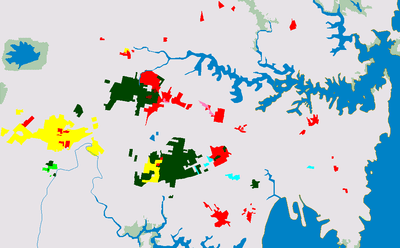Languages of Australia
| Languages of Australia | |
|---|---|
| Official languages | N/A |
| Main languages | Australian English (80%) |
| Indigenous languages | Australian Aboriginal languages, Tasmanian languages, Torres Strait Island languages |
| Minority languages | Mandarin Chinese (1.6%), Italian (1.4%), Arabic (1.3%), Greek (1.3%), Cantonese (1.2%) |
| Sign languages |
Auslan Yolŋu Sign Language and other Aboriginal sign languages |
| Common keyboard layouts |
 |
Australia has no official language, but is largely monolingual with English being the de facto national language. Australian English has a distinctive accent and vocabulary. According to the 2011 census, 76.8% of people spoke only English at home. Other languages spoken at home included Mandarin 1.6%, Italian 1.4%, Arabic 1.3%, Cantonese 1.2% and Greek 1.2%.[1]
A considerable proportion of first- and second-generation migrants are bilingual. It is believed that there were almost 400 Australian Aboriginal languages at the time of first European contact. Only about 70 of these languages have survived and all but 30 of these are now endangered. An indigenous language remains the main language for about 50,000 (0.25%) people. Australia has a sign language known as Auslan, which is the main language that approximately 10,000 deaf people use.
English
Australian English (AuE, AusE, en-AU) is the form of the English language used in Australia. Australian English has a distinctive accent and vocabulary.
Indigenous languages

Australian Aboriginal languages
There were almost 400 languages spoken by Indigenous Australians prior to the arrival of Europeans. Most of these are now either extinct or moribund, with only about fifteen languages still being spoken among all age groups of the relevant tribes.[2]
The Aboriginal languages with the most speakers today are Arrernte, Kala Lagaw Ya, Tiwi, Walmajarri, Warlpiri, and the Western Desert language.
Tasmanian languages
All the indigenous languages of Tasmania are extinct today, and little reliable information about them was recorded.
Torres Strait languages
Two languages are spoken on the islands of the Torres Strait, within Australian territory, by the Melanesian inhabitants of the area: Kala Lagaw Ya and Meriam Mir. Meriam Mir is a Papuan language, while Kala Lagaw Ya is an Australian language.
Pidgins and creoles
Two English-based creoles have arisen in Australia after European contact: Kriol and Torres Strait Creole. Kriol is spoken in the Northern Territory, and Torres Strait Creole in Queensland.
Broome Pearling Lugger Pidgin was a pidgin used as a lingua franca between Malays, Japanese, Vietnamese, Torres Strait Islanders and Aborigines on pearling boats.
Other minority languages


The maps show collection districts in Sydney and Melbourne, Australia, colour coded for languages other than English most spoken at home according to the 2006 Census.
In the 2001 census, 2,843,851 Australians reported speaking a language other than English at home, including 50,978 speakers of Indigenous languages. Other languages were:
|
|
|
Other languages spoken in Australia, according to Ethnologue, include Adyghe, Afrikaans (12,655 speakers), Basque, Western Cham, Estonian, Fijian Hindustani, Hebrew, Indo-Portuguese, Northern Kurdish (11,000 speakers), Cham, Latvian (25,000 speakers), Lithuanian (10,000 speakers), Cocos Islands Malay, Mambae, Assyrian Neo-Aramaic (30,000 speakers), Chaldean Neo-Aramaic, Nung, Piemontese, Pukapuka (140 speakers), Romanian, Traveller Scottish, Senaya, Slovene, Sylheti, Tai Dam, Tongan, Turoyo (2,000 speakers), Unserdeutsch, Uyghur, Northern Uzbek, Welsh and Eastern Yiddish. There is also the developing Italo-Australian Dialect that is not officially recognised by the Australian government but has been noted by linguists throughout Italy and Australia; the number of speakers is unknown.
Recent census history
According to the 2011 census, 76.8% of people spoke only English at home. Other languages spoken at home included Mandarin 1.6%, Italian 1.4%, Arabic 1.3%, Cantonese 1.2% and Greek 1.2%.[3]
According to the 2006 census, close to 79 per cent of Australia’s population spoke only English at home. The three most common languages other than English were Italian (accounting for 1.6 per cent of the population), Greek (1.3 per cent) and Cantonese (1.2 per cent).[4]
According to the 2001 census, English was the only language spoken in the home for around 80% of the population. The next most common languages spoken at home were Chinese (2.1%), Italian (1.9%), Vietnamese (1.7%) and Greek (1.4%).
See also
Diminutives in Australian English
References
- ↑ http://www.censusdata.abs.gov.au/census_services/getproduct/census/2011/quickstat/0
- ↑ McConvell, P. & N.Thieberger. 2001. State of Indigenous Language Report. http://www.environment.gov.au/soe/2001/publications/technical/indigenous-languages.html
- ↑ http://www.censusdata.abs.gov.au/census_services/getproduct/census/2011/quickstat/0
- ↑ http://www.abs.gov.au/websitedbs/d3310114.nsf/4a256353001af3ed4b2562bb00121564/b554a65c14112402ca25784500118462!OpenDocument
External links
| Wikimedia Commons has media related to Languages of Australia. |
